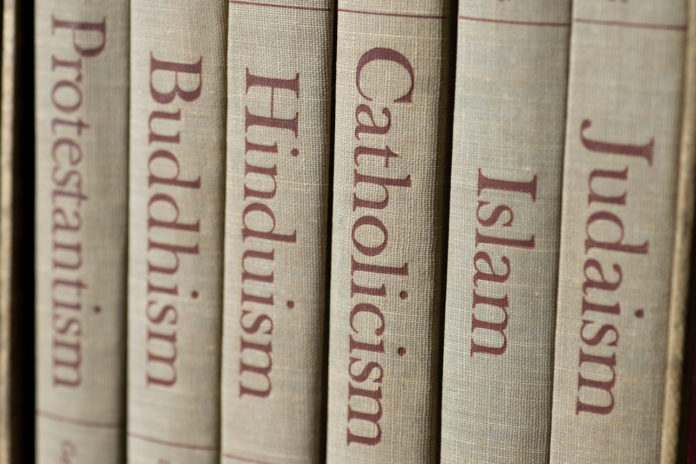
The blockchain, it is said, changes everything. An Ethereum developer takes this motto seriously by trying to subordinate the beliefs of religions to a smart contract on ethereum. The idea is not so dumb as it sounds at first.
Currently, a religion or a framework for religions is formed on the Ethereum Blockchain. The “founder of the religion” is Matt Liston, the former CEO of Augur, a startup trying to form a decentralized prediction market on Ethereum. Liston has dropped out of the dispute over Augur and is currently seeking $ 152 million in judicial redress. At the same time, he is working on a project that does not really know if it’s meant seriously or as a joke.
On May 19th, Liston, who is a self-confessed atheist, introduced his Blockchain religion in New York’s New Museum, which he calls 0xΩ. Observers are not sure whether to pronounce this as “Nothing of Omega” or “Zero Omega”. It does not make sense either way either way. Liston distributed 40 printouts of a document among the attendees of the event, which he calls the “Flame Paper” of 0xΩ. What exactly is in this scripture is probably not completely known, but at least there are second hand reports about it.
Forbes was at the event and reported about it. The inspiration or enlightenment underlying 0xΩ, the reporter says, is the way the blockchain allows a group of people or machines to consensus. Liston’s aim is to build a “religious framework” that allows religions to more quickly update their beliefs and democratize the relationships between members and the consensus they all believe in.
The magazine Futurism recognizes in Liston’s project the fundamental idea “that the blockchain releases a faith community from the need of governing authority.” Most of the religions of the present day, chiefs – the pope, the Dalai Lama – have the religious truths around them the crowd of believers trickles down. These themselves have virtually no influence on what the core beliefs of a religion are.
You could imagine that the Ethereum Full Node running in the basement becomes a shrine. Through him, the believer knows what everyone in his religious community believes, and through him, he has a voice when it comes to changing parts of the sacred texts on the blockchain – even the flaming paper – or the money the believers donated to distribute. Needless to say, a blockchain would make the use of donations much more transparent than is possible under current church organizations.
The Blockchain can thus receive the beliefs of the religion for a very long time in such a way that changes are possible, but comprehensible. If the community of believers can not agree, they can split into different religions via Hardfork, as demonstrated by Bitcoin and Bitcoin Cash as well as Ethereum and Ethereum Classic. The comparison is less limping than you might think, as the Hardforks of Bitcoin and Ethereum have also been about fundamental beliefs. Whether this means that the heretics emigrate from the Ethereum Blockchain, such as the Ethereum Classic Chain, or that only a religious token splits, is not yet clear.
From a follower Liston was already called on the event “Kryptsias” and “Kryptophet”, names, but he rejects. In general, it is much less his intention to found a new religion or to become its guru, but to provide its framework to the already established world religions. He believes that these could benefit from the blockchain by further developing their theological framework with the feedback of the faithful or administering the donations more democratically.
Liston seems to take the idea seriously. It may be argued that he simply does not understand that people in their practice of religion are less concerned with self-determined beliefs, but that they recite the sacred phrases written down by people who have a more direct connection with God. But at the same time, one could also mention that religions have always grown from new media, such as the wine on his cane, and that finding a consensus through a blockchain could actually help some churches to bring their beliefs to a common denominator and possibly evolve. Perhaps the 0xΩ framework could also become a useful tool to create new religions, churches or denominations.
As amusing as the whole idea seems at first glance, it has a much more profound content that can hold a mirror to many members of the scene: a blockchain is an infallible documentation of a history that puts it near a scripture, and what might explain why the digital communities around a block chain often look like cults or religions. There is probably an inner relationship between religions and blockchains, and cryptocurrencies are not only an instrument of financial activity but also store worldviews. A project like Liston’s could help make that implicit, underlying connection more explicit – and perhaps actually use it for real religions.
image by shutterstock

TheBitcoinNews.com – Bitcoin News source since June 2011 –
Virtual currency is not legal tender, is not backed by the government, and accounts and value balances are not subject to consumer protections. TheBitcoinNews.com holds several Cryptocurrencies, and this information does NOT constitute investment advice or an offer to invest.
Everything on this website can be seen as Advertisment and most comes from Press Releases, TheBitcoinNews.com is is not responsible for any of the content of or from external sites and feeds. Sponsored posts are always flagged as this, guest posts, guest articles and PRs are most time but NOT always flagged as this. Expert opinions and Price predictions are not supported by us and comes up from 3th part websites.
Advertise with us : Advertise
Our Social Networks: Facebook Instagram Pinterest Reddit Telegram Twitter Youtube










